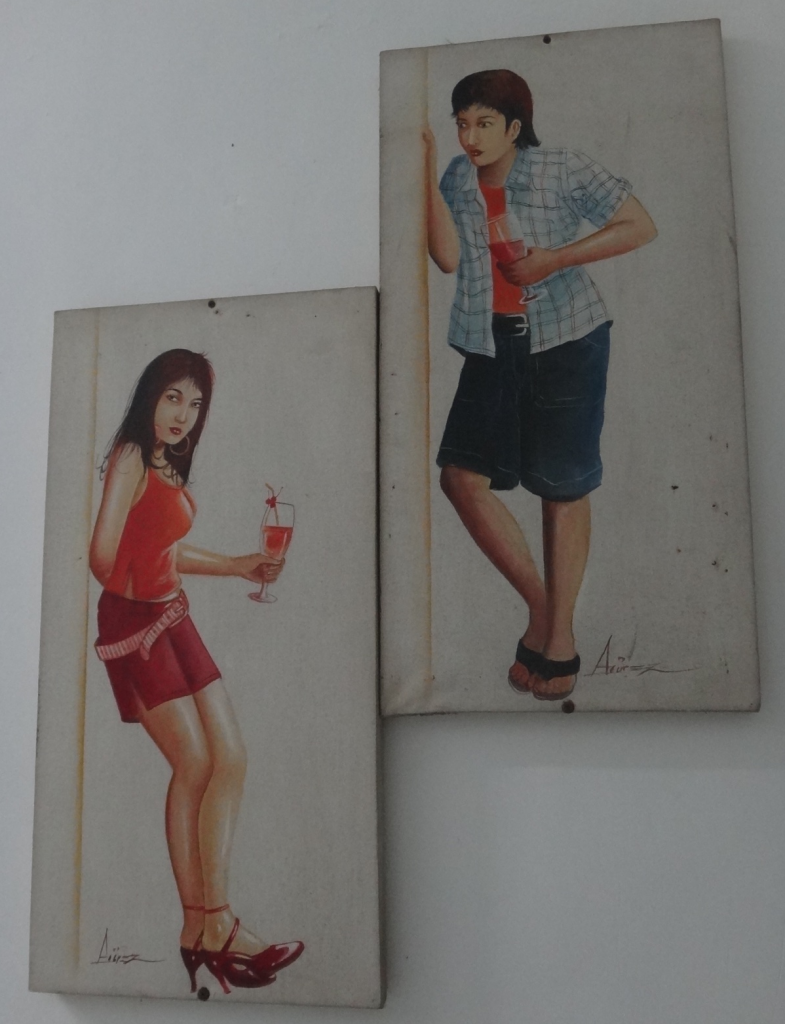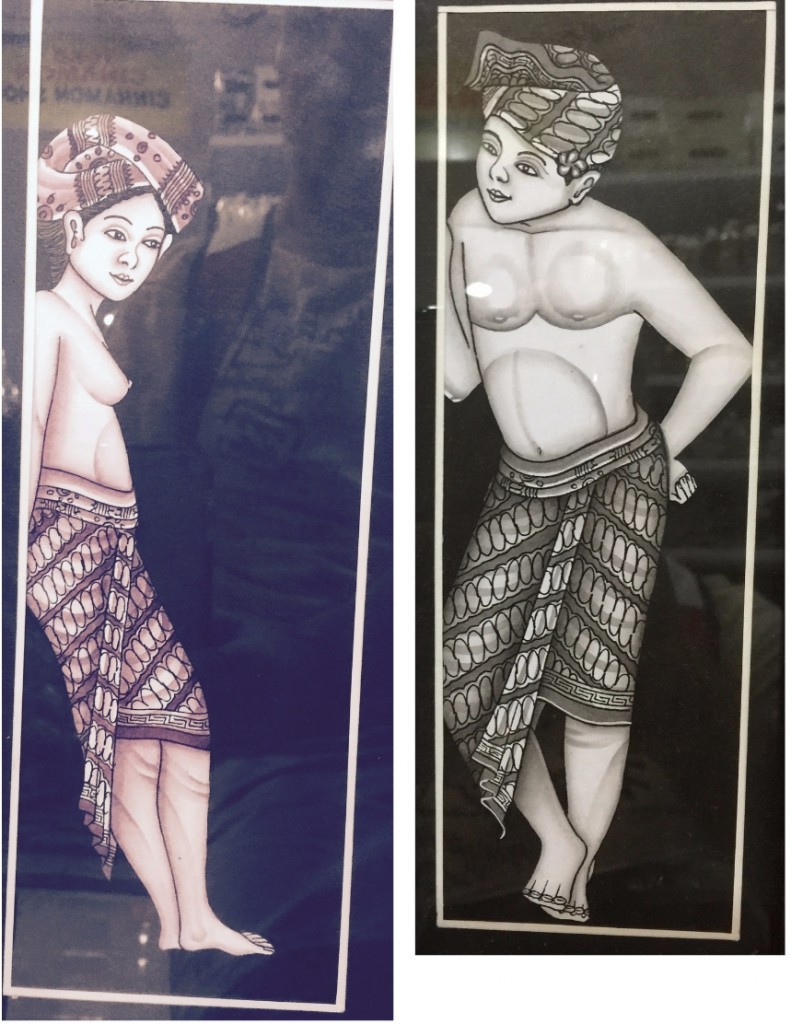I won’t repeat the arguments of Samuel Sandmel here. Too many words. Pictures are easier to read.
Not too long ago when I was visiting Indonesia’s island of Lombok I saw the following pair of pictures in the stairway of my hotel and recognized them instantly — yet I had never seen them before.
What I had seen before, several times in various tourist places around Java and Bali, were the following:
or many slight variants . . .
There is no doubt that the pictures I saw in Lombok are derived from the traditional portraits even though I am sure I could list more differences than similarities between them. Through its clear debt to its predecessors the modern images bring out the universality and timelessness of the theme of youthful boy-girl attraction.
But look at another set of parallels. This time, candidates for real parallelomania:
Recently I updated my Facebook profile picture. I had been fooling around on my computer and accidentally captured a photo of myself that I decided to trim and use.
I was about to replace my other images with this newer one but baulked. It reminded me of Roger Viklund’s blog profile photo. Not that I think Roger’s portrait is not worth emulating, but, well…
People would think I was being a copy cat. Damn you Roger. You got to it first.
And then there’s our colleague James Crossley on The Jesus Blog.
So what is the difference between the first set of comparisons and the second set? Why do we recognize the first as deliberate “mimesis” and the second as just plain chance? (I’m assuming here I had no subconscious motivation to look just like the cool and relaxed Roger and James.)
Here’s how I see it (you may identify additional “criteria”):
“Real Parallels”
Plausible (better still, demonstrable) contact between the different works
Both the differences and the similarities are clearly explicable as derivatives and enhance the meaning of the latter work.
Parallelomania
Similarities are explicable without reference to causal or derivative relationships.
Similarities and differences do not enhance the meaning or interpretability of the latter.
If you enjoyed this post, please consider donating to Vridar. Thanks!







But many people prop up their heads with their hand, because of our in- common biological, skeletal structure.
So as Poststructuralist structuralists, we can often find meaningful relations, parallels, in-common class relationships, where many see coincidence.
Granted, that first sense of some casual likeness would ideally be next verified. By indeed say, finding an in-common causal connection.
Neil, I’m thinking that there is evidence you tried to put some distance between your FB profile and the other photos. If your photo had been flipped horizontally to keep it from being too parallel with the others, it would account for your ring not being on the traditional left hand. Flipping back, horizontally, would also leave your right hand free to manipulate your computer mouse. No? 🙂
It seems likely that your left/right rotation had a purpose. Do you think the ancients may have had similar motivations while in the process of creating their “inadvertant” parallels?
For me, the issue to address is the degree of parallelism. Many conservative Christians are used to a high degree of obvious similarities between related scriptures. What they often demand as proof of relation therefore, is near-Identity.
But when looking for predecessors for Jesus, there are only vague “foreshadowings” and precursors, in “the suffering servant” and so forth.
So when looking for the mythic origins of Jesus, not so much resemblance is required, to better the existing Christian record.
A couple of comments that I think are related here:
Last night I watched a segment on irony on Stephen Fry’s QI and this snippet from a discussion about irony came up: Abraham Lincoln was shot in Ford’s Theatre while John F. Kennedy was shot in a Ford Lincoln – not ironic, just a coincidence.
Quoting from Sandmel’s article:
Resting one’s head on one’s hand is a common enough tendency for anyone who sits at a table or desk. So is leaning against a wall in either of the two poses we see in the paintings. If the explanation for the parallels that we see in both instances is nothing more than people being caught by chance in similar common poses then we have no “real” or meaningful parallel. The difference with the paintings is that they gain meaning by being interpreted through their antecedents. This meaning is clearly there because we know the creator was almost certainly familiar with the traditional portraits and was using their motifs in a way that adds interpretability to his or her new work.
The hand-to-head is more like the result of the Tanakh being something in common to a wide variety of literature and mere coincidence.
If we see people in our societies leaning against walls like the above boy and girl we are no more likely to think they are deliberately posing like a Balinese youth than anyone is likely to think I am consciously aping Roger or James.
Though if I wanted to mock either of them in a friendly way I could make a special point of imitating their postures.
It is not the quantity of differences/similarities but the meaning that can legitimately be derived from the context that makes the difference. (I think.)
Neil
I think this was McDondald’s 6th criteria in ‘The Homeric Epics and the Gospel of Mark’; he called this criteria interpretability – how one text (the hypotext) explains the other (the hypertext).
Yes indeed. Quite so. (They are set out at http://vridar.info/xorigins/homermark/mkhmrfiles/index.htm#criterialist) One could apply other criteria to what I have mentioned here. I was mainly thinking the questions through for myself, trying to figure out why it was that I could say one is “mimesis” while the other is coincidence.
Another one of MacDonald’s is “density” of similarities. It just occurred to me this does not say: “more similarities than differences”. It’s the differences that give us the leverage for interpretability.
It is important to see similarities, or points in common. As well as noting differences, changes. Seeing links to the Torah, but then changes to it.
By the way, I still hold out hope for Crossley et alia. At times they will make remarks critical of traditional religion. And they seem open say, to different “Jesuses.” From there it isn’t such a large step, to no Jesus at all.
There are two ways to handle opponents. Either hammer the differences, or seek common ground. Both methods are useful.
I suppose I agree. The NT has many obvious parallels to the OT. But more important are the places where it diverged, to become a separate religion from Judaism. I suggest that in particular, parallels with Greco Roman myths show that the crucial change came from this other cultural source, outside Judism proper.
An excellent concise summary. What we now need is a comprehensive work of serious, carefully documented scholarship to develop this theme.
Working on it, in fact….
No way! Three’s a trend, and once it’s a trend you surely_have_to do it! Come on it’s like the newest, hippest, most unknown thing, bro…and you can get in on the ground floor.